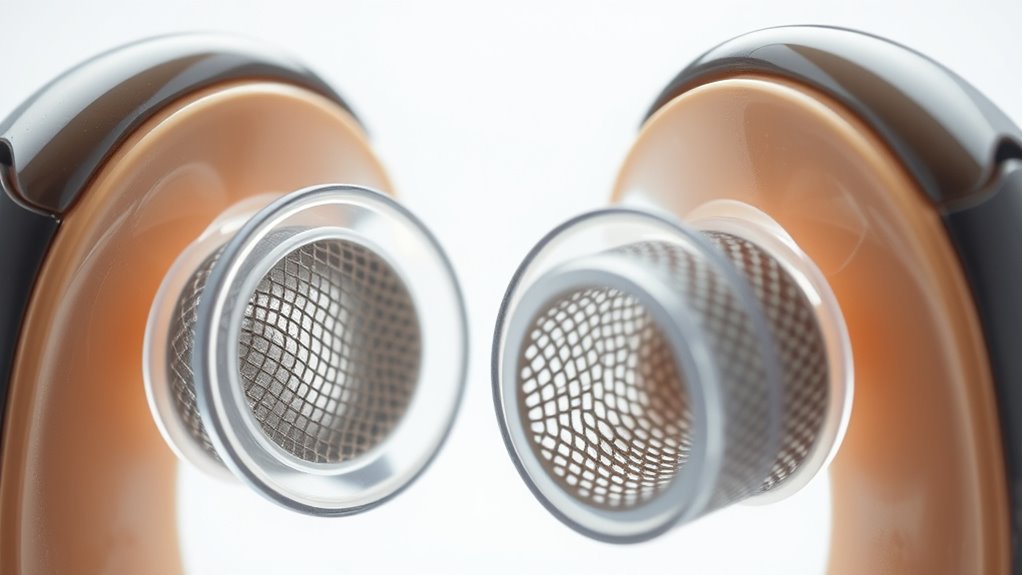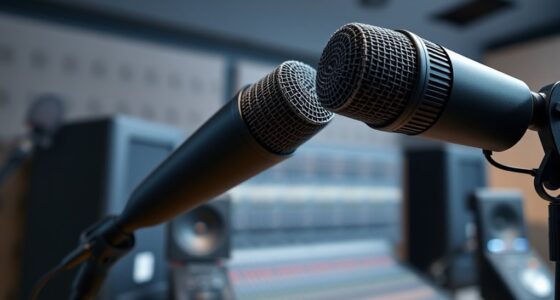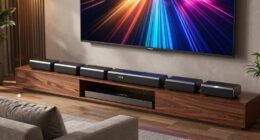Wax guards and filters are small parts in your hearing aids or devices that keep earwax, dust, and debris from blocking microphones and receivers. They help your devices work better by preventing clogging and damage, ensuring clear sound and lasting performance. Regularly checking and replacing these filters is key to maintaining sound quality and device health. Want to learn more about proper care and maintenance? Keep exploring for helpful tips.
Key Takeaways
- Wax guards and filters block earwax, dust, and debris from microphones and receivers.
- They prevent clogging, helping maintain clear sound quality and device performance.
- Regular replacement or cleaning ensures optimal airflow and prevents feedback issues.
- Proper filter maintenance extends the lifespan of hearing aids and protects internal components.
- Using the correct filters and following proper procedures ensures effective device protection and longevity.

If you wear hearing aids or use other small electronic devices, understanding wax guards and filters is essential for maintaining ideal performance. These tiny components play a vital role in keeping your devices functioning smoothly by blocking out earwax, dust, and debris that can otherwise clog the microphones and receivers. Proper hearing aid maintenance isn’t just about cleaning the device; it involves regularly checking and replacing these filters to guarantee optimal sound quality and device longevity. Neglecting them can lead to decreased sound clarity, increased feedback, and even damage to the internal components.
Understanding wax guards and filters is key to maintaining hearing aid performance and longevity.
Filter replacement tips are straightforward but crucial. First, familiarize yourself with your specific device’s instructions, as filter types and replacement procedures can vary. Most hearing aids come with a small tool or pickup, designed to help you gently remove and insert new filters. When replacing the filter, do so in a clean, dry environment to prevent introducing additional dirt or moisture. You’ll want to gently pull out the old filter without applying excessive force, then carefully insert the new one until it clicks into place. Regular check-ups, at least once a month, are recommended to catch any buildup early. If you notice reduced sound quality, whistling sounds, or a decrease in volume, it’s probably time for a filter change.
In addition to routine replacements, keep an eye on how the filters look. Over time, they can become clogged or discolored, signaling they’re no longer effective. Some filters are disposable and should be replaced frequently, while others are reusable with proper cleaning. For reusable filters, clean them gently with warm water and a soft brush, then allow them to dry completely before reinsertion. Remember, clean filters promote better airflow and sound transmission, which directly impacts your hearing aid performance.
Understanding sound healing science can also inspire you to incorporate calming sounds into your routine, supporting overall ear health and well-being. Incorporating these maintenance habits into your routine ensures your hearing aids stay in top shape. It’s a simple step that can greatly extend the lifespan of your device and improve your overall listening experience. Always carry spare filters with you, especially if you’re out and about for extended periods. If you’re unsure about how often to replace filters or how to do it correctly, consult your audiologist or the device manual. Taking these small but important steps will keep your hearing aids functioning as intended, providing you with clear, reliable sound whenever you need it. Proper hearing aid maintenance, including timely filter replacement, is the best way to enjoy maximum performance and comfort from your device.
Frequently Asked Questions
How Often Should Wax Guards Be Replaced?
You should replace your wax guard regularly during hearing aid maintenance, typically every 4 to 6 weeks, or sooner if you notice reduced sound quality or feedback. The wax guard lifespan varies depending on how much earwax you produce. Keep an eye on your hearing aids and replace the wax guard promptly to maintain peak performance and prevent damage. Regular replacements ensure your hearing aids function smoothly and last longer.
Can Filters Be Cleaned or Only Replaced?
You can clean filters, but it depends on their type. For example, a hearing aid filter may be cleaned gently with a soft brush or mild soap, extending its durability. Proper cleaning methods help maintain performance and prolong lifespan. However, some filters are designed for replacement only. Always check manufacturer instructions to make certain you’re not damaging the filter, and remember that cleaning can be effective for certain types, ensuring longer-lasting protection.
Do Wax Guards Affect Hearing Aid Sound Quality?
Wax guards can impact your hearing aid’s sound quality, especially if ear wax buildup affects their function. When wax accumulates, it can muffle or distort sound, making it harder to hear clearly. Regularly checking and replacing wax guards guarantees they don’t block sound or cause distortion. By maintaining your wax guards, you help preserve ideal sound quality and prevent ear wax impact from diminishing your hearing aid’s performance.
Are There Compatible Wax Guards for All Hearing Aids?
Think of hearing aid maintenance like tending a garden—you need the right tools to keep everything thriving. Not all hearing aids share the same wax guard compatibility; some models require specific guards. So, yes, there are compatible wax guards for many hearing aids, but it’s essential to check your device’s make and model. Using the correct wax guard ensures maximum performance and prolongs your hearing aid’s lifespan.
What Are Signs That Filters Need Replacement?
If you notice wax buildup or experience distorted sound, it’s a sign your filters need replacing. Filter malfunctions can cause reduced hearing aid performance, so check for decreased volume, static, or whistling sounds. Regularly inspecting your hearing aids for these issues helps prevent problems. Replacing filters promptly ensures clear sound and peak performance, protecting your devices from damage caused by wax buildup or debris.
Conclusion
Now you know how wax guards and filters keep your hearing aids working smoothly. Did you know that over 70% of hearing aid malfunctions are caused by wax buildup? Regular cleaning and replacement can boost your device’s lifespan and performance. Don’t wait for issues to arise—stay proactive with maintenance. By understanding these tiny but mighty components, you guarantee your hearing aids stay clear and effective, so you never miss a beat.











